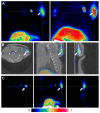Visualization of gene therapy with a liver cancer-targeted adeno-associated virus 3 vector
- PMID: 32127946
- PMCID: PMC7052912
- DOI: 10.7150/jca.39579
Visualization of gene therapy with a liver cancer-targeted adeno-associated virus 3 vector
Abstract
Background: To evaluate the feasibility of a self-complementing recombinant adeno-associated virus 3 (scrAAV3) vector targeting liver cancer and non-invasively monitor gene therapy of liver cancer. Materials and methods: An scrAAV3-HSV1-TK-kallistatin (ATK) gene drug was constructed, which contained the herpes virus thymidine kinase (HSV1-TK) reporter gene and human endogenous angiogenesis inhibitor (kallistatin) gene for non-invasive imaging of gene expression. Subcutaneous xenografted tumors of hepatoma in nude mice were generated for positron emission tomography/computed tomography (PET/CT) imaging. The ATK group was injected with the ATK gene through the tail vein, and an imaging agent was injected 2 weeks later. PET/CT imaging was performed at 1 hour after injection of the imaging agent. The control group was injected with phosphate-buffered saline at the same volume as the ATK gene drug. HE staining is used for pathological observation of tumor sections. HSV1-TK and kallistatin expression was identified by immunofluorescence, real-time quantitative PCR, and western blotting. Results: Radioactivity on PET/CT images was significantly higher in the ATK group compared with the control group. 18F-FHBG uptake values of left forelegs in ATK and control groups were 0.591±0.151% and 0.017 ± 0.011% ID/g (n=5), respectively (P<0.05). After injection of the ATK gene drug, mRNA and protein expression of HSV1-TK and kallistatin in subcutaneous xenograft tumors was detected successfully. In vitro analysis demonstrated significant differences in the expression of HSV1-TK and kallistatin between ATK and control groups (P<0.05). Conclusions: The scrAAV3 vector has a strong liver cancer-targeting ability, and the ATK gene drug can be used for targeted and non-invasive monitoring of liver cancer gene therapy.
Keywords: Liver cancer; Molecular imaging; Self-complementary recombinant adeno-associated virus 3; Targeted therapy.
© The author(s).
Conflict of interest statement
Competing Interests: The authors have declared that no competing interest exists.
Figures





Similar articles
-
Imaging adenoviral-mediated herpes virus thymidine kinase gene transfer and expression in vivo.Cancer Res. 1999 Oct 15;59(20):5186-93. Cancer Res. 1999. PMID: 10537296
-
[Molecular imaging for PET-CT reporter gene in breast adenocarcinoma (HSV1-tk) of subcutaneous xenografts in living nude mice].Zhonghua Yi Xue Za Zhi. 2009 Dec 29;89(48):3420-4. Zhonghua Yi Xue Za Zhi. 2009. PMID: 20223118 Chinese.
-
18F-FHBG PET-CT Reporter Gene Imaging of Adoptive CIK Cell Transfer Immunotherapy for Breast Cancer in a Mouse Model.Onco Targets Ther. 2020 Nov 13;13:11659-11668. doi: 10.2147/OTT.S271657. eCollection 2020. Onco Targets Ther. 2020. PMID: 33223839 Free PMC article.
-
8-[18F]Fluoropenciclovir: an improved reporter probe for imaging HSV1-tk reporter gene expression in vivo using PET.J Nucl Med. 2001 Jan;42(1):96-105. J Nucl Med. 2001. PMID: 11197989
-
Herpes simplex virus thymidine kinase as a marker/reporter gene for PET imaging of gene therapy.Q J Nucl Med. 1999 Jun;43(2):163-9. Q J Nucl Med. 1999. PMID: 10429512 Review.
Cited by
-
Comprehensive Analysis of Hexokinase 2 Immune Infiltrates and m6A Related Genes in Human Esophageal Carcinoma.Front Cell Dev Biol. 2021 Oct 7;9:715883. doi: 10.3389/fcell.2021.715883. eCollection 2021. Front Cell Dev Biol. 2021. PMID: 34708035 Free PMC article.
-
Overexpression of METTL3 associated with the metabolic status on 18F-FDG PET/CT in patients with Esophageal Carcinoma.J Cancer. 2020 Jun 7;11(16):4851-4860. doi: 10.7150/jca.44754. eCollection 2020. J Cancer. 2020. PMID: 32626532 Free PMC article.
-
Imaging of adeno-associated viral capsids for purposes of gene editing using CEST NMR/MRI.Magn Reson Med. 2024 Aug;92(2):792-806. doi: 10.1002/mrm.30058. Epub 2024 Apr 23. Magn Reson Med. 2024. PMID: 38651648 Free PMC article.
-
Comprehensive Analysis of YTHDF1 Immune Infiltrates and ceRNA in Human Esophageal Carcinoma.Front Genet. 2022 Mar 23;13:835265. doi: 10.3389/fgene.2022.835265. eCollection 2022. Front Genet. 2022. PMID: 35401696 Free PMC article.
-
Advances About Immunoinflammatory Pathogenesis and Treatment in Diabetic Peripheral Neuropathy.Front Pharmacol. 2021 Oct 4;12:748193. doi: 10.3389/fphar.2021.748193. eCollection 2021. Front Pharmacol. 2021. PMID: 34671261 Free PMC article. Review.
References
-
- Chen W, Zheng R, Baade PD, Zhang S, Zeng H, Bray F. et al. Cancer statistics in China, 2015. CA Cancer J Clin. 2016;66:115–132. - PubMed
-
- Wolf MJ, Adili A, Piotrowitz K, Abdullah Z, Boege Y, Stemmer K. et al. Metabolic activation of intrahepatic CD8+ T cells and NKT cells causes nonalcoholic steatohepatitis and liver cancer via cross-talk with hepatocytes. Cancer Cell. 2014;26:549–564. - PubMed
-
- Wang Z, Ma HI, Li J, Sun L, Zhang J, Xiao X. Rapid and highly efficient transduction by double-stranded adeno-associated virus vectors in vitro and in vivo. Gene Ther. 2003;10:2105–2111. - PubMed
LinkOut - more resources
Full Text Sources

